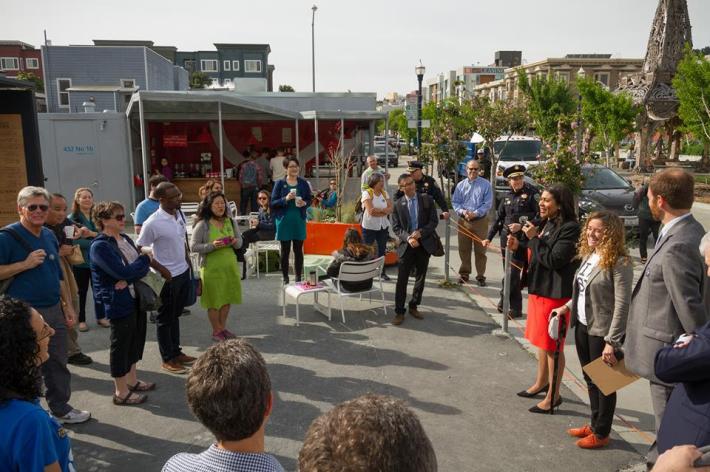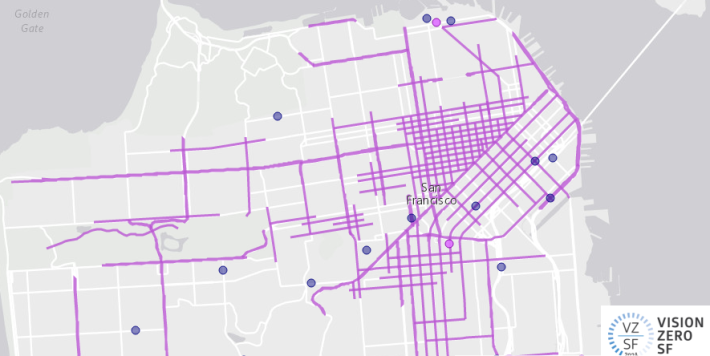
A little less than a week ago, Walk San Francisco held its fourth annual "Walk to Work Day" events. The idea is to get people more aware of the health benefits of walking. From Walk SF's promotion:
Walking at least 15 minutes of your commute counts! Start your healthy walking habit and get rewarded at one of the Walk to Work Day “hubs” across the city. Stop by for a FREE Clipper Card, totes, coffee, or breakfast snack, and much more!
While there was reason to celebrate walking in San Francisco, this year's event came shortly after a sobering piece in the San Francisco Chronicle listed a spate of road deaths in early 2016:
In addition to the six pedestrian deaths, three people in a car were killed in a Super Bowl Sunday crash on a city street, and a cable car operator hit by an allegedly drunken motorcyclist in June 2015 died of his injuries in January.
As the article made clear, people just keep getting hurt and killed despite San Francisco's efforts to make its streets safer. The Chronicle cited safe-streets advocates as putting the blame on a system that prioritizes parking availability over safety; a critique Streetsblog has levied for some time:
Vision Zero, San Francisco’s ambitious program to eliminate traffic deaths, is off to a rough start this year — with six people in crosswalks struck and killed by cars and accusations that the Municipal Transportation Agency is protecting parking instead of pedestrians. [emphasis added]
After the story came out, Streetsblog sat down with Nicole Ferrara, Executive Director of Walk SF, and a leading activist for safer streets, to ask if she agreed with its conclusions and, if so, why she thinks Vision Zero isn't having a more tangible effect.
Streetsblog: So you saw the Chronicle story. Is it right to conclude that the Vision Zero efforts, so far, have failed?
Ferrara: It’s been a little over two years since we started Vision Zero. There are a couple of things that point to certain treatments that are working--the SFMTA has started to evaluate and they are showing positive results in terms of yielding to pedestrians in the crosswalk. That, plus speeding, are the top two causes of death and serious injury. However, I think we don’t have a ton of projects in the ground that are comprehensive yet.
Streetsblog: In other words, it's too soon to say?
Ferrara: Right. The city did a good job of doing quick effective spot treatments and getting in the rhythm of increasing project delivery, but the projects that have hit the ground are not transformative and are not the type of projects that we expect to really create the safe streets we need to get to Vision Zero.
Streetsblog: You mean things aren't going far enough--take Market and Taraval, two streets we've talked about before.
Ferrara: Yes. You have projects such as "Safer Market Street" where we've compromised so much...
Streetsblog: You're referring to the left-turn-not-really-restricted restrictions?
Ferrara: The project is supposed to restrict dangerous turns, but it allows commercial drivers, Muni vehicles and others to turn anyway...we've compromised so much that almost everyone can turn. People have died as a result.
Streetsblog: Like Thu Phan, the woman who was run down in the crosswalk in her wheelchair?
Ferrara: (Nodding) We need to stop compromising on safety and we need to be building the projects that are going to save lives. Now that we don't have Levels of Service as a barrier, it removes a huge time suck and waiting period.
Streetsblog: But there's still pushback from the community, as you know. Whenever you try to make a street safer, say, by removing some parking spots that may obscure sight lines, you get people shouting.
Ferrara: I think people are going to be resistant to change no matter what. Merchants say their businesses will suffer if parking is moved around the corner, for example. But it's just the opposite. When you create more transit-rich places for people to walk, local businesses thrive.
Streetsblog: Like with the Taraval project. That's getting a ton of pushback from merchants.
Ferrara: Supervisor Katy Tang has not stepped up to support that project. We need our politicians to say "your business will not suffer" and "people are dying." We got a report about a visually impaired person who walked off the Taraval train last week and his cane got hit by a passing car--thank God it wasn't him--but without basic safety treatment, there's no guarantee that won't happen.
Streetsblog: At the start of the public meeting on Muni's plans for Taraval, Supervisor Tang said she was there to listen. But then I heard someone from the audience say 22 people hit while alighting [from] trains "doesn’t seem like that many.” All I could think was, "I hope Tang's not listening to voices like that."
Ferrara: How many death and near-death experiences have to happen before we get basic safety items like boarding islands? Boarding islands shouldn't even be a conversation. It should just get done. Let's talk about other enhancements, such as speed cameras, if we want to have a conversation.
Streetsblog: What's next? How do we make sure Vision Zero garners more tangible results?
Ferrara: I think overall, the city has been increasing delivery and the number of projects. But we need to redouble our commitment to the quality of projects we’re talking about and having our city leaders, whether it's at MTA, or a Supervisor in the Outer Sunset, or the mayor’s office--they all need to be pushing for the safest treatments possible. Vision Zero is not about compromising; it’s about doing the safest things and figuring out the rest later.






